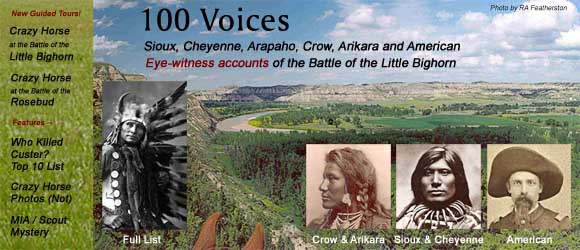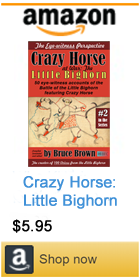|
||||||||||||
Bruce Brown's 100 Voices... Little Knife's Story of the Battle
The memory of the [Custer] battle was still fresh in the minds of the Indians who took part in it. The story told in the summer of 1879 in the camp of the Uncapapas in the Wood Mountain region of southern Canada, and assented to by three or four warriors who corroborated each other, is to the effect that General Custer was killed by a lad of 15 years of age. [Note: actually Custer was probably killed before this by White Cow Bull at the river; see Who Killed Custer -- The Eye-Witness Answer for more info.] The General was cheering his men and firing his pistol in the air -- the cavalry signal to charge -- it was stated. From the start he was in advance of his command. When he fell he was between the Indians on horseback and his own flying squadron. While trying to restore some order in his broken ranks, a stray shot killed a young buck not far from General Custer's position. The dead warrior's brother, an Indian lad 15 years of age, seized his brother's gun and shot Custer dead, according to the Wood Mountain recital. The boy was still in the camp in the Wood Mountain country and he carried a coup stick in which there was a deep notch to represent the taking-off of one of the best Indian fighters the Plains ever knew. After the battle, for a brief period, the Indians gathered around the body of "Long Hair," as they called the General, and loud and jubilant was the requiem sung over the dead soldier... Little Knife said that as soon as the soldiers struck camp and the battle opened, the Indians saw that they had an inferior force to contend with. The men were poor riders and, according to Little Knife, were easily shaken from their horses. In firing their carbines and later their pistols they were wild, and in retreating they fired over their shoulders, killing their own comrades as they went. Both horses and men appeared to be unmanageable from the outset, he said, and they fell a prey to the steady firing of the Indian enemy and the careless and reckless shooting among themselves. Some who were thrown from their horses approached the Indians with their hands up, but they were shot down. One prisoner was taken. He was captured by Rain-in-theFace, who said he had stripes on his arm. The prisoner was undoubtedly Corporal Ryan. He was bound hand and foot with a "shag-a-nappe" (stripped buffalo hide), and left in a lodge. A wild dance followed in the night after the battle, and a few men, drunk with the excitement of the results of the conflict, sought out the lodge in which the captive was held and killed him with a knife.... "Sitting Bull had very little to do with the big battle," said Little Knife. "He was on the butte (hill) on the flank of the Indian camp. Towards the close of the fight he was in the camp keeping it in order and looking after the women and children." "Who was the chief in command?" Little Knife was asked. "There was none," he replied. "The headmen commanded the men under them, but there was no general chief." "How many did the Indians lose?" he was asked. The old chief named each one of the Indian casualties and counted them on his fingers. "There were 32 Indians actually killed," he said. "How many soldiers?" "I can't say; a great many."
"We got seven hundred guns and pistols. We also got two horns (bugles) and a flag," he replied. It was observed in the Indian camp that almost every Uncapapa was armed with a breech loading carbine that was taken off the battlefield. No trace of the bugles was found. The standard was made up into a shirt for one of the young bucks who wore it with the red and white stripes running perpendicular and the blue field of stars hanging over his back. Little Knife was asked if any scalps were taken. "No, not one," he replied. "We scalped nobody; we came away as fast as we could." "How many soldiers did you kill?" was asked directly of the Uncapapa chief. "None; I never killed a white man in my life. I have only killed Crow Indians." Little Knife is believed to have perjured himself in that reply. "Are you on the warpath now with the Americans?" "No," replied Little Knife, "I am a warrior. My heart is strong; I am brave, but I don't want war. I am tired of fighting. I am not willing to go back to my country, even if the Americans will let me. I don't want to give up my guns and horses. I want to hunt; but I will hurt no man unless he hurts me. Indian Views of the Custer Fight: A Source Book by Richard G. Hardorff, The Arthur Clark Co. Spokane, WA 2004, p 53 - 56
According to David Humphreys Miller, Little Knife later identified the Anonymous Boy who he said killed Custer as Brown Back, older brother of Deeds, who was murdered by the Seventh Cavalry at the very beginning of the battle, as described by Drags The Rope. Little Knife does not make that assertion here, though, perhaps out of legitimate fear of American retribution (Little Knife was then on the run with Sitting Bull in Canada). * * * Just as most Indians denied mutilating the Seventh Cavalry dead after the Battle of the Little Bighorn, most Indians denied that any American prisoners were taken. Little Knife is the only Indian survivor who acknowledged that at least one Seventh Cavalry prisoner was captured and killed after the battle, the night of June 25. Seventh Cavalry scout George Herendeen said, "The heads of four white soldiers were found in the Sioux camp that had been severed from their trunks, but the bodies could not be found on the battlefield or in the village." Click here for more information on Seventh Cavalry fatalities whose bodies were never found.
|
||||||||||||




 [Woody Mountain, Canada] [Summer, 1879]
[Woody Mountain, Canada] [Summer, 1879] "Did your people get many trophies?" Little Knife was asked.
"Did your people get many trophies?" Little Knife was asked.







